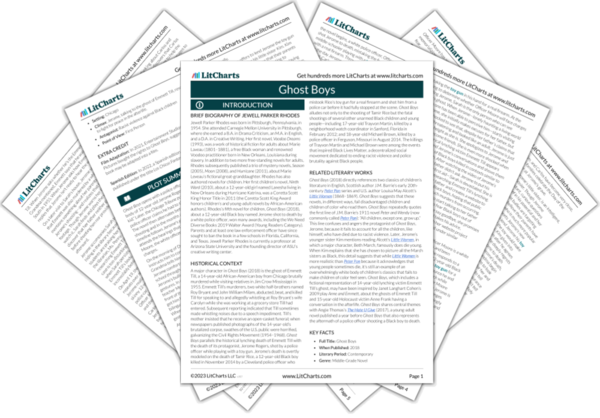Ghost Boys implicitly argues that while legally mandated racial discrimination has ended in the U.S., the U.S. legal system has remained racist because people enforce the law in racist ways. This argument is clearest in the novel’s representations of Officer Moore, who shoots 12-year-old Black boy Jerome Rogers to death in Chicago, and of the judge who determines whether Officer Moore will be charged with a crime. Officer Moore claims that he is not racist. Yet when he responds to a 911 call about a boy or man with a gun, Officer Moore sees short, skinny, 12-year-old Jerome playing with a toy gun and perceives him as an adult man brandishing a deadly weapon at him, presumably due to racist stereotypes about dangerous Black men. Officer Moore shoots Jerome twice in the back as Jerome runs away from his police car—and even after he realizes that Jerome is a child, neither he nor his partner offers Jerome first aid. Officer Moore’s killing of Jerome emphasizes that even when the law is “race neutral,” law enforcement can fatally discriminate against Black people whom it is supposed to protect and serve. Meanwhile, the judge at Officer Moore’s preliminary hearing decides not to bring charges against the officer. When she explains her reasoning, she refers to the toy Jerome was playing with as a “realistic-looking gun” and Jerome himself as a “young man,” even though he was a short, 12-year-old seventh grader. The judge’s wording reveals that she has accepted a racist narrative according to which a small Black boy playing outside can reasonably seem like an adult and a possibly fatal threat to an armed police officer. Thus, Ghost Boys emphasizes that the law cannot truly respect racial equality until the people who enforce the law are no longer influenced by racist stereotypes.
Racism and the Law ThemeTracker

Racism and the Law Quotes in Ghost Boys
I’m dead.
I thought I was bigger. Tough. But I’m just a bit of nothing.
My arms are outstretched like I was trying to fly like Superman.

Unlock explanations and citation info for this and every other Ghost Boys quote.
Plus so much more...
Get LitCharts A+I’m pudgy, easily teased. But when I’m a grown-up, everybody’s going to be my friend. I might even be president. Like Obama.
Ma always says, “In this neighborhood, getting a child to adulthood is perilous.”
I looked up the word. Perilous. “Risky, dangerous.”
“Emmett. Just like Emmett Till,” says Grandma. “He was a Chicago boy, too.”
“This isn’t 1955,” says Reverend, calming.
“Tamir Rice, then,” shouts Pop. “2014. He died in Cleveland. Another boy shot just because he’s black.”
“You’re nothing in Chicago. Say it.” Snap twists Carlos’s arm. “Say it, ‘I’m nothing.’”
“Black lives matter!” someone hollers.
Strangely, courtroom benches remind me of church pews. Long, hard, polished wood.
“An emergency nine-one-one call, a young man with a realistic-looking gun, a concern for public safety, and an officer’s fear for his life are all facts I’ve considered.
“In the opinion of this court, there is not enough evidence to charge Officer Moore with excessive force, manslaughter, or murder.”
Emmett’s the leader. The leader of our crew. An unnatural alliance—young, but dead.
Ghost boys.
I understand now. Everything isn’t all about me.











